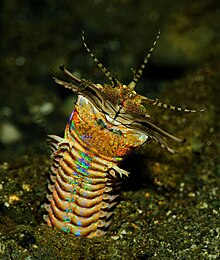| Eunice aphroditois | |
|---|---|

| |
| A burrowed Eunice aphroditois | |
| Scientific classification | |
| Domain: | Eukaryota |
| Kingdom: | Animalia |
| Phylum: | Annelida |
| Clade: | Pleistoannelida |
| Subclass: | Errantia |
| Order: | Eunicida |
| Family: | Eunicidae |
| Genus: | Eunice |
| Species: | E. aphroditois
|
| Binomial name | |
| Eunice aphroditois Pallas, 1788
| |
Eunice aphroditois is a benthic bristle worm of warm marine waters. It lives mainly in the Atlantic Ocean, but can also be found in the Indo-Pacific.[1][2] It ranges in length from less than 10 cm (4 in) to 3 m (10 ft).[3] Its exoskeleton displays a wide range of colors, from black to purple and more. This species is an ambush predator; it hunts by burrowing its whole body in soft sediment on the ocean floor and waiting until its antennae detect prey.[4] It then strikes with its sharp mandibles.[5] It may also be found among coral reefs.
Eunice aphroditois is also known as the bobbit worm[6][7] or bobbitt worm.[8] The name is believed to be taken from the John and Lorena Bobbitt case;[9] however, another proposed reason is due to its jaw. It is sometimes called the sand striker.[8] Another name associated with them is trap-jaw worm. Traces of their burrows have been noted in 2021 to have been found among fossils near Taiwan dating back twenty million years.[10]
- ^ Cite error: The named reference
giangrande2003was invoked but never defined (see the help page). - ^ Cite error: The named reference
wormswas invoked but never defined (see the help page). - ^ Kubota, Shin; Tanase, Hidetomo; Uchida, Hiro'omi (March 2009). "An extraordinarily large specimen of the polychaete worm Eunice aphroditois (Pallas) (Order Eunicea) from Shirahama, Wakayama, central Japan". Kuroshio Biosphere. 5: 9–15. ISSN 1349-2705.
- ^ Cite error: The named reference
haag2016was invoked but never defined (see the help page). - ^ Study, Australian Biological Resources (2000). Polychaetes & Allies: The Southern Synthesis. Csiro Publishing. ISBN 9780643065710.
- ^ Goslinger, Terrence (1996). Coral Reef Animals of the Indo-Pacific. Sea Challengers. ISBN 0930118219.
- ^ Cite error: The named reference
slbwas invoked but never defined (see the help page). - ^ a b Cite error: The named reference
bbccormierwas invoked but never defined (see the help page). - ^ Debelius, Helmut (2001). Asia Pacific Reef Guide: Malaysia, Indonesia, Palau, Philippines, Tropical Japan, China, Vietnam, Thailand. IKAN. p. 305. ISBN 9783925919565.
- ^ Black, Riley, Giant predatory worms lurked beneath the ancient seafloor, fossils reveal, National Geographic, January 21, 2021